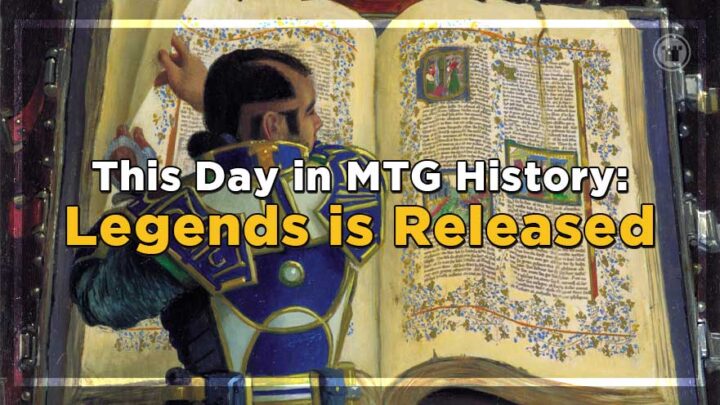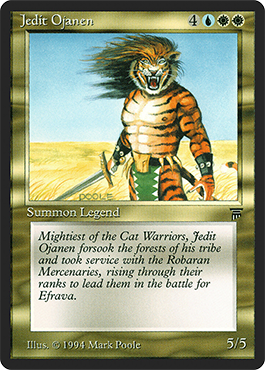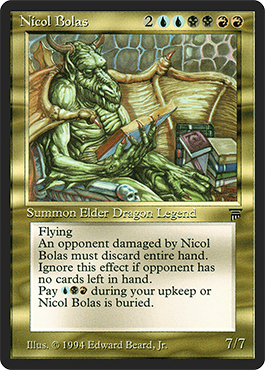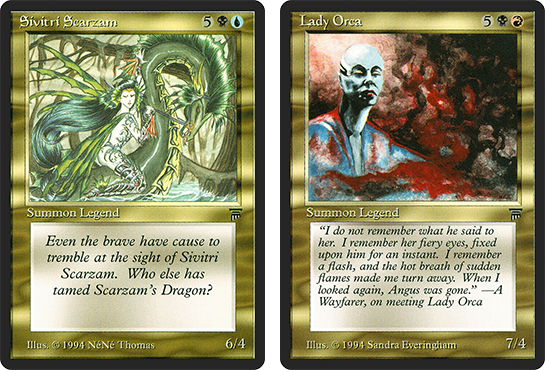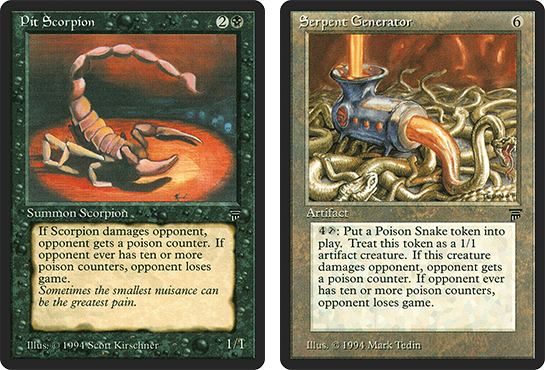Nizzahon looks at a significant event on this day in MTG history. On June 10th, 1994, Legends was released!
Welcome to another edition of “This Day in Magic History.” This time around, we’re taking a look at the release of Legends. Overall, I think Legends is a set that is not fondly remembered. When people talk about it, it is usually to discuss how laughably bad the cards in it are. I’m not here to tell you that Legends doesn’t have a ton of bad cards in it. It does. The most infamous are the multicolored Legendary Creatures who are just overcosted vanilla creatures, like Jedit Ojanen.
However, I am here to tell you that, in terms of design, Legends might be the most innovative set apart from Alpha. Legends introduced two concepts that became a big part of Magic, and funnily enough they are both represented by Jedit Ojanen! Legends was the first set to feature multicolored cards and legendary permanents. In this article, we’ll take a look at the introduction of each of these concepts, and their long-term implications.
Legends: The First Set With…Legends
Obviously enough, the set’s name clues you in on the importance of Legends in the set. When Legends debuted, legendary permanents worked a little bit differently than they do today. Back when they were first introduced, “Legend” was a creature type. If a creature had it, you could only play a single copy of that card in your deck. In terms of flavor, these legends represented unique individuals, so it made sense that you couldn’t have multiples of them in your deck. The rule didn’t remain this way for very long, as by 1995 the “Legend Rule” was introduced. While it isn’t identical to what we have today, the basic premise was that there couldn’t be more than one copy of a legendary creature in play at a time. The “Legend Rule” would change a few more times over the years, eventually shifting from a creature type to a supertype, like “basic” on lands. These days of course, each player can have a single copy of any legendary permanent in play, it isn’t something that checks the entire board for another copy of the creature.
Introducing legendary permanents was a big deal. First, it made it easier to have cards in the game represent the lore surrounding the game, which was becoming increasingly more complex. People were now able to play cards that represented characters from the lore.
Legendary creatures are of course also central in Commander – which has become Magic’s most popular format. It was from this very set that “Elder Dragon Highlander” (EDH) was born. Among the Legendary Creatures in the set there was a cycle of Elder Dragons. This cycle of Dragons became the first Commanders among those who first created the format.
Nicol Bolas made his debut in this set, and he does a great job of representing how important the introduction of Legendary creatures was. In addition to being one of the eponymous “Elder Dragons” in “Elder Dragon Highlander,” he has also gone on to be one of the most enduring villains in all of Magic’s lore.
Legends Introduced the First Multicolored Cards
Multicolored cards also made their debut in Legends. In other words, every single card ever printed up to this point was only a single color. While making a card cost more than one type of mana seems obvious, it wasn’t something that was present in Magic from the beginning. Today, multicolored cards and sets with multicolored themes are some of the most popular cards in the game. Most Magic decks in all formats are more than one color, and most of them feature multiple multicolored cards, and Legends is the first place we ever saw them! It is quite difficult to imagine a version of Magic completely devoid of these types of cards.
Okay, but Why Are the Multicolored Legends So Bad?
As I said at the beginning, there are many terrible cards in Legends. Oddly enough, many of the cards in the set that are bad actually feature both of this set’s innovative mechanics! The majority of the set’s multicolored Legends are awful. This seems really odd, since these days Wizards of the Coast tends to really push new mechanics hard, so that they make an immediate impact. They did the exact opposite with Legends. This is especially strange because both of these mechanics come with downsides. Multicolored cards are harder to cast than monocolored ones. While the “Legend Rule” has changed over time, it has always come with some downsides.
I know some might say that these cards are only bad today because of power creep, but most of them were awful when they made their debut too! Cards like Jedit Ojanen, Lady Orca and Sivitri Scarzam have never been good. While the set did introduce these important new mechanics, the actual execution on them was definitely lacking. What’s the point in printing a Legendary Creature if you’re just going to make it an overcosted vanilla creature?
Some Other “Firsts” in Legends
Part of the set’s bad reputation also comes from its introduction of two awful mechanics: Rampage, and Bands with Other. Rampage made a creature bigger if it got blocked by more than one creature, and “Bands With Other” was a restrictive form of the Banding mechanic that only allowed a creature to band with something with the same type it has. Both of these mechanics were weak and highly situational. Neither of them have stood the test of time, with both of them entirely out of the picture two years later.
However, Legends was also the first set to introduce poison counters as an alternate win condition. Sort of like with multicolored and legendary cards, their execution wasn’t very good. It appeared on only two fairly weak cards. However, the very concept of poison counters was quite innovative, and it would become a major part of multiple formats many years later, with the introduction of the Infect mechanic.
Parting Words
I hope this article has convinced some Legends haters to take another look at the set’s legacy. The set does have a lot of bad cards in it, but it drastically altered the trajectory of Magic. Without Legends, we wouldn’t have the Legendary supertype (or the Commander format) or multicolored cards, and Magic’s lore wouldn’t be nearly as well-integrated into the game. Today, all three of these things are things we expect to see in every single set release. Luckily, the multicolored legendary creatures they give us these days aren’t terrible! And, if you’re an Infect player, you have Legends to thank for introducing your favorite win condition!
Thanks for reading! I’ll be back next week with a look at another important event in Magic history!

Jacob has been playing Magic for the better part of 24 years, and he especially loves playing Magic’s Limited formats. He also holds a PhD in history from the University of Oklahoma. In 2015, he started his YouTube channel, “Nizzahon Magic,” where he combines his interests with many videos covering Magic’s competitive history. When he’s not playing Magic or making Magic content, he can be found teaching college-level history courses or caring for a menagerie of pets with his wife.

